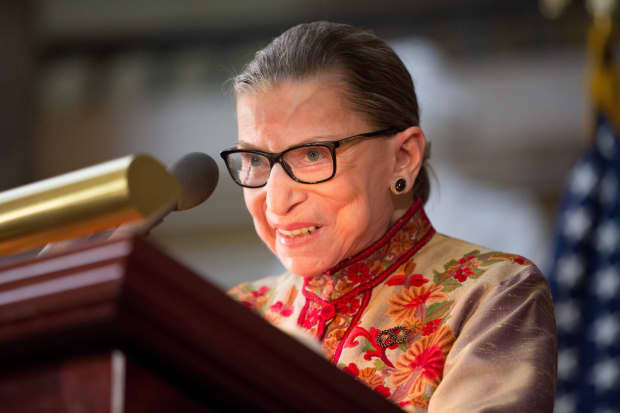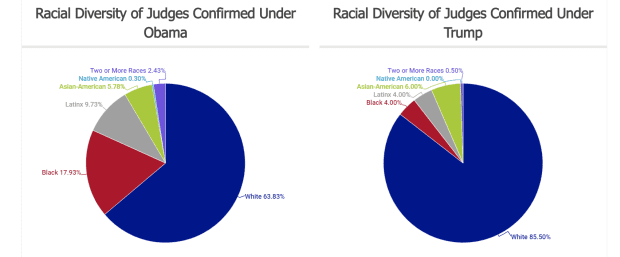This post was originally published on this site

Supreme Court Justice Ruth Bader Ginsburg, 87, has vowed to stay on the court as long as she can do the work. She disclosed last week that she’s being treated for cancer, yet again.
Allison Shelley/Getty Images
We’re selecting a lot more than the next president in November. We’re also selecting the next Supreme Court.
It’s important to remember that while presidents come and go, their judicial appointees hang around for decades, all but guaranteeing that a president—even a one-termer as Donald Trump may be—can put his or her stamp on the country for a generation or two to come.
This is one reason, perhaps the biggest reason, why so many Republicans put up with Trump and overlook all the dishonesty, corruption and infantile behavior that has sullied the Oval Office. It’s all about the judges. Republicans love the fact that Trump has sent scores of judges to Mitch McConnell’s GOP-led Senate to swiftly approve.

The judges nominated by President Trump are overwhelmingly white.
American Constitution Society
Trump and McConnell make a formidable team. They have now gotten 200 judges approved, mostly white, mostly male, mostly young. But all are conservative, which means that long after 74-year old Trump and 78-year old McConnell have left the scene (both could be gone in six months), their judicial progeny will live on, well into midcentury.
Not done yet
In fact, their work is just about done. “When we depart this chamber today,” McConnell said earlier this month, “there will not be a single circuit court vacancy for the first time in at least 40 years.”
Follow the latest election news on MarketWatch
But their work isn’t quite finished. There may be one more thing that Trump and McConnell could do, and that is to ram at least one more Supreme Court nominee through over the next few months, if a vacancy opens up. And why not two, while they’re at it? Sounds implausible, but after the last four norm-busting years, who’s to say?
There are a couple of scenarios here. The most obvious one is that Justice Ruth Bader Ginsburg is forced to step down or, God forbid, passes away. Ginsburg is 87 and just announced that she is undergoing chemotherapy after discovering cancer in her liver. “RBG,” as her many admirers call her, is the court’s senior liberal justice, appointed by President Bill Clinton in 1993. Over the past two decades she has battled colon cancer, pancreatic cancer and lung cancer, reports the Associated Press.
For all their bland “We wish Justice Ginsburg a speedy recovery” statements, Senate Republicans are chomping at the bit to replace her, and for a bunch of old fat men (mostly), would move faster than Olympic sprinter Usain Bolt to do so.
You’ll recall that Trump’s two prior Supreme Court appointees—Neil Gorsuch and Brett “I like beer” Kavanaugh—were each pushed through the Judiciary Committee in just four days: Gorsuch in March 2017 and Kavanaugh in September 2018, before winning final approval from the full Senate itself. If Trump and McConnell had their way, a third SCOTUS appointee would also move quickly.
Partisan playbook
But wait a minute. It’s inappropriate to hold confirmation hearings on a Supreme Court nominee in an election year, isn’t it? That’s what McConnell said in 2016, when he refused to allow hearings for Merrick Garland, who was nominated by President Barack Obama to fill the seat vacated by the death of Justice Antonin Scalia.
Back then, McConnell argued that “this nomination ought to be made by the president we’re in the process of electing this year.”
OK. So by that logic, since it looks like former Vice President Joe Biden could be “the president we’re in the process of electing this year,” the Senate should obviously wait—as it did in 2016, right?
Don’t be silly. “If you’re asking me a hypothetical…we would fill it,” McConnell said back in February.
You see, blocking nominations on the pretense of “it’s an election year” is only applicable if the president is of the other party.
The next Senate won’t be sworn in until early January, which means Trump and McConnell could both lose their re-election bids in November, but still ram someone through in a lame-duck session. If Biden is elected president and Democrats take the Senate, there’s not a damn thing they could do to prevent it.
Step aside for a younger man
The other possibility could involve asking one of the older conservatives on the court to retire, thus paving the way for a younger conservative to keep the seat for decades to come.
Clarence Thomas is the oldest. He was appointed to the court by President George H.W. Bush in 1991—at age 43. He just turned 72. I doubt Thomas is ready to retire, but you never know. A Biden victory would make him more likely to stick around much longer—sort of like how RBG is trying to ride out the Trump era.
The other variable is this: What happens if Biden wins but Republicans hold on to the Senate? Ginsburg turns 88 in March, and Stephen Breyer, the next oldest liberal on the court, turns 82 in August. An opening would give the new president an opportunity to nominate a liberal (perhaps even Merrick Garland again?). What would McConnell—if he wins re-election—do? Stall until 2024 in the hopes that a Republican is elected president?
The possibilities are endless, and it’s unclear what will happen. What is clear, however: the future makeup of he Supreme Court—and with it, decisions on everything from guns, abortion, civil rights and more—is also on the ballot 3½ months from now.
More from Paul Brandus
The numbers don’t look so good for Donald Trump
Does age matter for a presidential candidate? Yes, but it’s only part of the picture
Don’t count Trump out yet—here’s how he can still win in November

